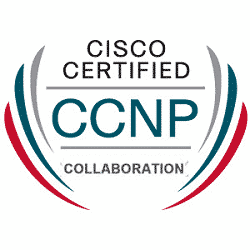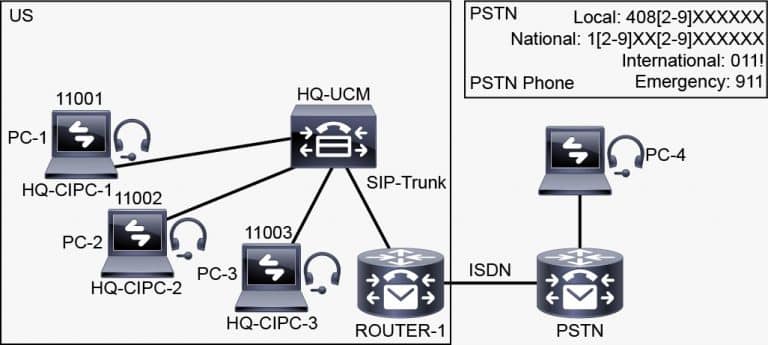Obiettivi | Certificazione | Contenuti | Tipologia | Prerequisiti | Durata e Frequenza | Docenti | Modalità di Iscrizione | Calendario

Il Corso CLCOR Implementing and Operating Cisco Collaboration Core Technologies, rappresenta il pilastro fondamentale del percorso tecnologico e di certificazione Collaboration. Esso infatti prepara il partecipante all’esame Core della Certificazione CCNP Collaboration (Esame 350-801). In questo corso si acquisiranno le competenze necessarie per implementare le tecnologie Cisco Collaboration fondamentali, partendo dallo studio generale delle architetture fino alla gestione e amministrazione di Cisco Unified Communications Manager (CUCM) passando da MGCP gateways, i Codec, Cisco Jabber, QOS and QOS Models , Cisco VoIP Bandwidth Calculator, Toll Fraud Prevention e tanto altro. Il Corso contribuisce alla preparazione dell’esame di Certificazione CCNP Collaboration (Esame 350-801).
Contattaci ora per ricevere tutti i dettagli e per richiedere, senza alcun impegno, di parlare direttamente con uno dei nostri Docenti (Clicca qui)
oppure chiamaci subito al nostro Numero Verde (800-177596)
Obiettivi del corso
Di seguito una sintesi degli obiettivi principali del Corso CLCOR Implementing and Operating Cisco Collaboration Core Technologies:
- Acquisizione delle competenze per implementare le principali tecnologie Cisco Collaboration.
- Studio approfondito delle architetture di Collaboration.
- Gestione e amministrazione di Cisco Unified Communications Manager (CUCM).
- Comprensione di MGCP gateways, Codec e Cisco Jabber.
- Approfondimento su QOS, Cisco VoIP Bandwidth Calculator e prevenzione delle frodi telefoniche.
Certificazione del corso
Esame 350-801 CLCOR Implementing Cisco Collaboration Core Technologies;
Esame Parte delle Certificazioni: CCNP Collaboration, CCIE Collaboration. Il programma di certificazione CCNP Collaboration prepara per i ruoli professionali nelle odierne tecnologie sulla collaboration. La CCNP collaboration ora include elementi di automazione e programmabilità per la massima scalabilità delle moderne infrastrutture di comunicazione. In particolare l’esame 350-801 CLCOR testa competenze su argomenti quali: implementing core collaboration technologies, infrastructure e design, protocols, codecs, endpoints, Cisco IOS XE gateway, media resources, call control, QoS, e collaboration applications.
Contenuti del corso
- Describing the Cisco Collaboration Solutions Architecture
- Overview of Cisco Collaboration Solutions Architecture
- Collaboration Deployment Models
- Licensing
- High Availability
- Capacity Planning
- Security Requirements
- Using Certificates
- Disaster Recovery
- Dial Plan
- IP Network Protocols
- Configure IP Network Protocols
- Codecs
- References
- Exploring Call Signaling over IP Networks
- IP Phone Initialization
- Single Site On-Cluster Calling
- Single Site On-Cluster Call Setup Troubleshooting
- Describe the Call Setup and Teardown Process
- Describe SIP Call Signaling for Call Setup and Teardown
- Configure and Troubleshoot Collaboration Endpoints
- Troubleshoot Calling Issues
- Compare the Call Control Protocols
- Describe DTMF Signaling over IP Networks
- References
- Integrating Cisco Unified Communications Manager LDAP
- Overview of LDAP Integration in Cisco Unified Communications Manager
- LDAP Synchronization in Cisco Unified Communications Manager
- LDAP Authentication in Cisco Unified Communications Manager
- LDAP Attribute Mapping in Cisco Unified Communications Manager
- LDAP Considerations in Cisco Unified Communications Manager
- Access Control Groups in Cisco Unified Communications Manager
- Feature Group Templates in Cisco Unified Communications Manager
- Configure and Troubleshoot LDAP Integration in Cisco Unified Communications Manager
- References
- Implementing Cisco Unified Communications Manager Provisioning Features
- Overview of Provisioning Options
- Deploy an IP Phone Through Auto and Manual Registration
- Self-Provisioning Prerequisites
- Self-Provisioning Components
- Self-Provisioning Authentication Modes
- Configure Self-Provisioning
- Batch-Provisioning Tools
- Configure Batch Provisioning
- References
- Exploring Codecs
- Define Codecs
- Compare Audio Codecs
- Compare Video Codecs
- Evaluate the Effects of Encryption on Codecs
- Explore the Cisco VoIP Bandwidth Calculator
- Describing Call Admission Control
- Configure Regions and Locations
- References
- Describing Dial Plans and Endpoint Addressing
- Dial Plan Overview
- Dial Plan Components and Their Functions
- Endpoint Addressing
- Overview of Cisco Unified Communications Manager Call Routing
- Cisco Unified Communications Manager Call-Routing Logic
- Address Methods and Digit Analysis
- Variable-Length Patterns, Overlapping Patterns, and Urgent Priority
- Implement Endpoint Addressing and Call Routing
- References
- Implementing MGCP Gateways
- Overview of MGCP Gateways
- MGCP Gateway Implementation
- Path Selection in Cisco Unified Communications Manager
- Route Groups
- Route Lists and Route Patterns
- Digit Manipulation in Cisco Unified Communications Manager
- Implement PSTN Calling Using MGCP Gateways
- References
- Implementing Voice Gateways
- Overview of Dial Peers
- Configure and Troubleshoot ISDN PRI
- Examine Cisco IOS Gateway Inbound and Outbound Dial-Peer Functions
- Digit Manipulation Features on Cisco IOS Gateways
- Implement and Troubleshoot Digit Manipulation on a Cisco IOS Gateway
- Codec and DTMF-Relay Selection on Cisco IOS Gateways
- References
- Configuring Calling Privileges in Cisco Unified Communications Manager
- Calling Privileges Overview
- Partitions and CSSs
- Partition and CSS Considerations
- Time-of-Day Routing
- Client Matter Codes and Forced Authorization Codes
- Configure Calling Privileges
- References
- Implementing Toll Fraud Prevention
- Toll Fraud Prevention Overview
- Cisco Unified Communications Manager CoS for Toll Fraud Prevention
- Implement Toll Fraud Prevention on Cisco Unified Communications Manager
- References
- Implementing Globalized Call Routing
- Overview of Multisite Dial Plans
- Globalized Call Routing Overview
- Globalized Call Routing Number Formats
- Globalization of Localized Call Ingress
- Localization During Call Egress
- Implement Globalized Call Routing
- References
- Implementing and Troubleshooting Media Resources in Cisco Unified Communications Manager
- Media Resources Overview in Cisco Unified Communications Manager
- Media Resource Selection and Access Control in Cisco Unified Communications Manager
- Describing the Annunciator Feature
- Describing Unicast and Multicast MOH Characteristics
- Audio and Video Conference Bridge Devices
- Audio and Video Conference Bridge Integration Options
- MTP and Transcoder Devices
- MTP and Transcoder Requirements
- References
- Describing Cisco Instant Messaging and Presence
- Describe Cisco IM and Presence Features and Architecture
- Compare the Protocols XMPP and SIMPLE SIP
- Clustering
- Describe Cisco Unified Communications IM and Presence Components and Communication Flows
- References
- Enabling Cisco Jabber
- Cisco Jabber Deployment Modes
- Cisco Jabber Operational Modes
- Deploy an On-Premise Cisco Jabber Client for Windows
- References
- Configuring Cisco Unity Connection Integration
- Overview of Cisco Unity Connection Integration
- SIP Integration
- Typical Integration Mistakes
- Integration Considerations
- Configure the Integration Between Unity Connection and Cisco UCM
- Manage Unity Connection Users
- References
- Configuring Cisco Unity Connection Call Handlers
- Call Handler Overview
- System Call Handler
- Caller Input
- Operator Call Handler
- Goodbye Call Handler
- Directory Handler
- Interview Handler
- References
- Describing Collaboration Edge Architecture
- Describe Collaboration Edge (Expressway-C, -E)
- Describe Supported Services for BB Collaboration
- Describe Prerequisites for Mobile and Remote Access
- Describe Service Discovery
- Explore Expressway Settings for MRA
- Describe Cisco Unified Border Element (CUBE)
- Analyzing Quality Issues in Converged Networks
- Converged Networks
- Available Bandwidth
- Components of Network Delay
- End-to-End Delay Calculations
- Jitter
- Packet Loss
- Defining QoS and QoS Models
- QoS Defined
- Network Traffic Identification
- Divide Network Traffic into Classes and Define Policies
- QoS Mechanisms
- QoS Models
- DSCP Encoding
- Expedited Forwarding and Assured Forwarding
- Class Selector
- Implementing Classification and Marking
- Classification and Marking Overview
- Classification and Marking at the Network and Data Link Layers
- QoS Service Class
- Cisco Marking Recommendations
- QoS Markings in a SIP Call Flow
- MQC Classification and Marking Options
- Configure QoS
- Configuring Classification and Marking on Cisco Catalyst Switches
- Campus Classification and Marking
- Overview of QoS Trust Boundaries
- Ingress QoS Models
- QoS Marking and Table Maps
- Internal DSCP
- References
Attività Laboratoriali
- Using Certificates
- Configure IP Network Protocols
- Configure and Troubleshoot Collaboration Endpoints
- Troubleshoot Calling Issues
- Configure and Troubleshoot LDAP Integration in Cisco Unified Communications Manager
- Deploy an IP Phone Through Auto and Manual Registration
- Configure Self-Provisioning
- Configure Batch Provisioning
- Explore the Cisco VoIP Bandwidth Calculator
- Configure Regions and Locations
- Implement Endpoint Addressing and Call Routing
- Implement PSTN Calling Using MGCP Gateways
- Configure and Troubleshoot Integrated Services Digital Network (ISDN) Primary Rate Interface (PRI)
- Examine Cisco IOS Gateway Inbound and Outbound Dial-Peer Functions
- Implement and Troubleshoot Digit Manipulation on a Cisco IOS Gateway
- Configure Calling Privileges
- Implement Toll Fraud Prevention on Cisco Unified Communications Manager (CUCM)
- Implement Globalized Call Routing
- Deploy an On-Premise Cisco Jabber Client for Windows
- Examine the Integration between Unity Connection and CUCM
- Manage Unity Connection Users
- Enterprise Application Integration (EAI): Configure QoS
Tipologia
Corso di Formazione con Docente
Docenti
I docenti sono Istruttori accreditati CISCO e certificati in altre tecnologie IT, con anni di esperienza pratica nel settore e nella Formazione.
Infrastruttura laboratoriale
Per tutte le tipologie di erogazione, il Corsista può accedere alle attrezzature e ai sistemi reali Cisco presenti nei Nostri laboratori o direttamente presso i data center Cisco in modalità remota h24. Ogni partecipante dispone di un accesso per implementare le varie configurazioni avendo così un riscontro pratico e immediato della teoria affrontata. Ecco di seguito alcune topologie di rete dei Laboratori Cisco Disponibili:

Dettagli del corso
Prerequisiti
Si consiglia la partecipazione al Corso Cisco CCNA.
Durata del corso
- Durata Intensiva 5gg;
Frequenza
Varie tipologie di Frequenza Estensiva ed Intensiva.
Date del corso
- Corso Cisco CLCOR (Formula Intensiva) – Su Richiesta – 9:00 – 17:00
Modalità di iscrizione
Le iscrizioni sono a numero chiuso per garantire ai tutti i partecipanti un servizio eccellente.
L’iscrizione avviene richiedendo di essere contattati dal seguente Link, o contattando la sede al numero verde 800-177596 o inviando una richiesta all’email [email protected].


